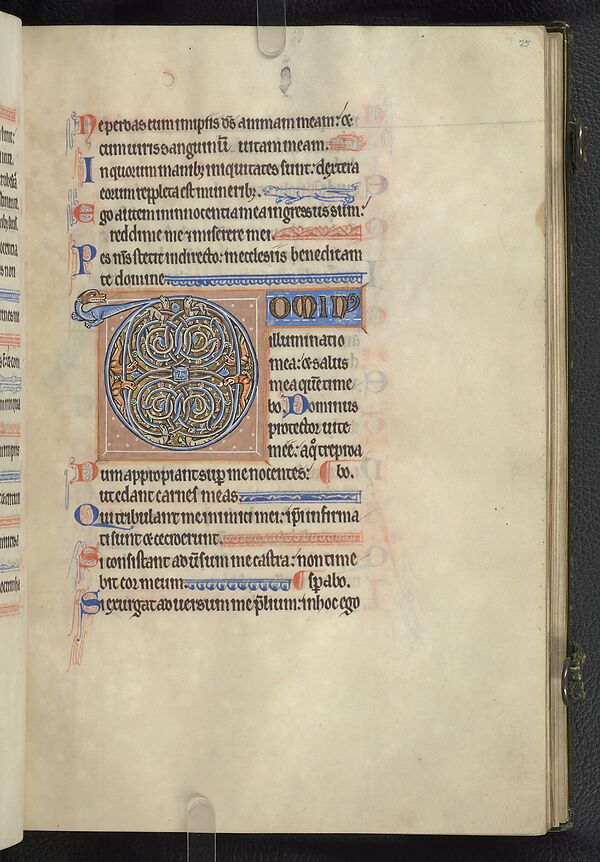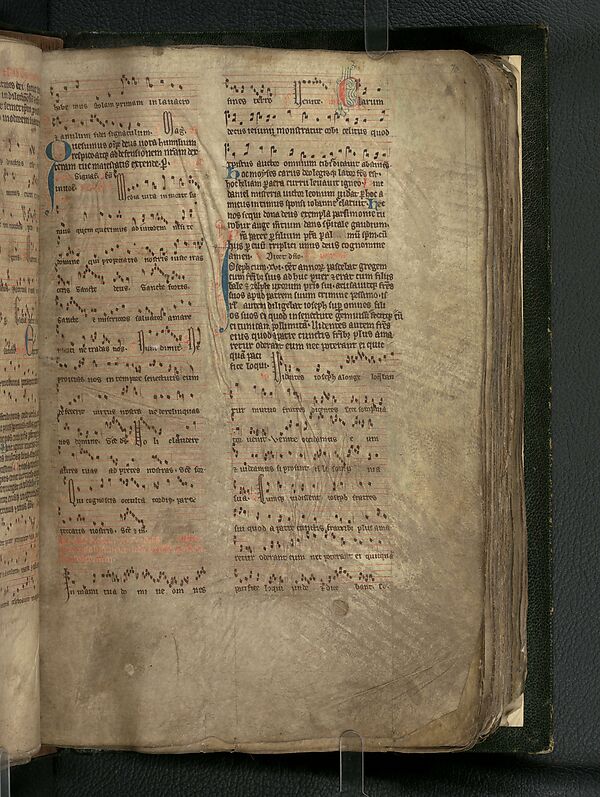Showing Browse Resources: 1 - 10 of 10
'Bohun Psalter' made in England in the late 14th-century for Eleanor de Bohun, Duchess of Gloucester.
Item
Identifier: Adv.MS.18.6.5
Scope and Contents
The contents of the manuscript are as follows:(i) Calendar in black, blue and red (folio 3). Entries in red include Saints Edward (18 March) and Dunstan (19 May), `Depositio sancti Augustini` (26 May), ordination of St Gregory (3 September) and translations of Saints Hugh (6 October) and Edward (13 October).(ii) Office of the Blessed Virgin Mary for Advent (folio 9) and from Christmas to the Purification (folio 11 verso).(iii) Confession, attributed in the...
Dates:
Late 14th century.
'Culross psalter', made for Richard Marshall, Cistercian abbot of Culross.
Item
Identifier: Adv.MS.18.8.11
Scope and Contents
The contents are as follows:(i) Calendar in red and black (folio 1). Entries in red include Saints Thomas Aquinas (7 March), Servanus (1 July), and Ninian (16 September), and in black, Saints Margaret of Scotland (19 June), Findoce (13 October) and the usual Cistercian saints. The calendar was published in ‘Kalendars of Scottish saints’, pages 53-64.(ii) Psalter and Canticles (folio 7). The Te Deum is omitted.(iii) Litany, including Saints Servanus, Blaan,...
Dates:
Circa 1470.

'Iona Psalter'.
Item
Identifier: MS.10000
Scope and Contents
The contents are as follows.(i) Calendar in black, red and blue. The KL initials, and the entries for the major festivals and for the feast of St Columba (9 June), probably intended to have been in gold, have not been completed. The feasts are fully graded with two entries for Saints Benedict, Augustine and Frideswide (12 February and 19 October). There are a number of English saints and also entries for the Scottish Saints Felan (8 January), Ciaran (4 March) and Finan (7 April)....
Dates:
4th quarter of 12th century-1st quarter of 13th century.

Late 13th-century manuscript known as the 'Sprouston Breviary'.
Item
Identifier: Adv.MS.18.2.13B
Scope and Contents
This manuscript was produced in Scotland in the late 13th century, probably sometime between 1285 and 1300 according to Hair and Knott. Borland, Frere and McRoberts have suggested that it may be of the early 14th century, but most scholars agree that it was written sometime around 1300. The manuscript contains musical services as well as the text of Church services according to the Use of Sarum. The work is written in littera textualis in double columns of unequal length....
Dates:
Late 13th century.
Manuscript known as the 'Herdmanstoun Antiphonal', or 'Herdmanstoun Breviary'.
Item
Identifier: Adv.MS.18.2.13A
Scope and Contents
Manuscript known traditionally as the Herdmanstoun Breviary, but more correctly described as an Antiphonal. It was written in the north of England, possibly Northumberland, but later taken to Scotland and altered. It has been suggested by Höhler that the manuscript was possibly written for the college of canons founded at Chester-le-Street by Bishop Anthony Bek of Durham. Bannister speculates that the volume may have been brought to Scotland during the reign of David II (1329-1371). ...
Dates:
Circa 1300
Manuscripts from Blairs College Library.
Collection
Identifier: Dep.221
Dates:
1177, 15th century-1924.
Microfilm of Psalter of French provenance; and, Book of hours.
Item
Identifier: Mf.Sec.MSS.532
Scope and Contents
The contents are as follows:
Psalter of French provenance, 2nd half of 15th century, written for a community of Dominican nuns (MS.7122);
Book of hours, 2nd half of 15th century, probably according to the Use of Rome (MS.7124).
Dates:
2nd half of 15th century.
Perth Psalter, containing calendar, psalter, canticles, and litany.
Item
Identifier: MS.652
Scope and Contents
Referred to as the Perth Psalter from the entry in the calendar on 3rd September, ‘Dedicacio ecclesie de Perth’.The calendar and the litany are based on the use of Sarum, with additional entries for Scottish Saints. There are several illuminated capitals, four of the larger of these are accompanied by full-page borders of conventional foliage. Accompanying the manuscript is a list of additions to the calendar in a later cursive hand which were brought out by chemical action by F...
Dates:
Late 15th century.
Psalter, probably written in the area around Liège in the 14th century
Item
Identifier: Adv.MS.18.8.17
Scope and Contents
The contents are as follows:(i) Calendar in red and black with solar notations and Easter on 27 March (folio 1). All the entries are among the feasts listed in ‘Gothic manuscript illumination in the diocese of Liège (c.1250-c.1330)’, ii, pages 214-228, except `Inventio sancti dyonisii` (22 April) in red. Saints Agatha, Egidius, Lambert, Remigius and Germanus, and Dyonisius cum sociis suis are also in red, and Saints Emmerentian, Gertrude, Ursmar, Remaclus, Hubert, and the...
Dates:
14th century.
'Ramsay psalter', written in France in the late 13th century for use at Saint Omer, and then in the possession of the Ramsay family of Colluthie
Item
Identifier: Adv.MS.18.8.8
Scope and Contents
The contents are as follows:(i) Calendar in black and red (folio 1) containing several saints of the Saint Omer region but not the relics of St Maxime at Thérouanne. It includes Saints Silvinus (17 February), Omer (8 June, 9 September, 21 October), Bertin (16 July and 5 September), Francis (4 October) and Folquinus (14 December). Saints Denis and Thomas Becket are in red. Obits have been added in later hands for Robert III, James V and various members of the Ramsay family of...
Dates:
Late 13th century.
